March 2023 Regulatory Update
On 9 February 2023, the U.S. Consumer Product Safety Commission (CPSC) proposed a rule to establish performance requirements for battery compartments on consumer products that contain or are designed to use one or more button cell or coin type battery and warning labels for button cell or coin batteries, as well as for consumer products containing button cell or coin batteries.
It is expected all consumer products containing button cell or coin batteries (except toy products) and all button cell or coin batteries that are manufactured or imported 180 days after publication of the rule in the Federal Register (August 2023), shall be subjected to the rule.
As required by Reese’s Law, to eliminate or adequately reduce the risk of injury from ingestion of button cell or coin batteries by children 6 years old and younger, the CPSC proposed to amend Title 16 of the Code of Federal Regulations (CFR) by adding 16 CFR Part 1263 –Safety Standard and Notification Requirements for Button Cell or Coin Batteries and Consumer Products Containing Such Batteries.
The following requirements were included in this rule:
- Performance requirements for consumer products containing removable button cell or coin batteries:
- Button cell or coin batteries in consumer products must not be able to be accessed during the accessibility test described in paragraph (d) of section 1263.3
- Battery compartments must be secured using the method specified in (b)(2) of section 1263.3 and must meet the performance tests described in paragraph (e) of section 1263.3, including pre-conditioning tests such as stress relief and battery replacement, and abuse tests such as drop test, impact test, crush test, compression test, torque test and tension test
- Performance requirements for consumer products containing non-removable button cell or coin batteries:
- Must comply with the requirement list in point 1
- Button cell or coin battery must be secured by soldering, fasteners such as rivets or equivalent means and pass the secureness test in paragraph (f) of section 1263.3
- Warning label requirement for button cell or coin battery packaging:
- Warning shown in Figure 4 of paragraph (b)(1) of section 1263.4 must be included on principal display panel

- If the space is not enough, the warning shown in Figure 5 to paragraph (b)(2) of section 1263.4 shall be on the principal display panel and the warning shown in Figure 6 of paragraph (b)(2) of section 1263.4 shall be on the secondary display panel
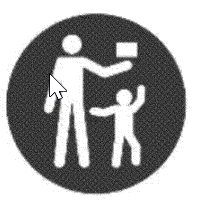

- Safety-related statements specified in (b)(3) of section 1263.4 must be included on the principal display panel or secondary display panel; this requirement is not applicable to button cell or coin batteries that are packaged and included separately with the consumer product
- Warning label requirements for packaging of consumer products containing button cell or coin batteries
- Warning shown in Figure 7 to paragraph (c)(1) of section 1263.4 must be contained on principal display panel
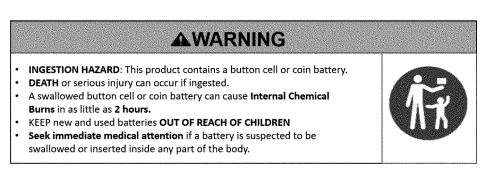
- If the space is not enough, the warning shown in Figure 8 to paragraph (c)(3) of section 1263.4 must be on the principal display panel and the warning shown in Figure 9 to paragraph (c)(3) of section 1263.4 must be on the secondary display panel

- If there is no packaging for the consumer product, the warning shown in Figure 7 to paragraph (c)(1) of section 1263.4 must be affixed to consumer product with a hang tag or a sticker label
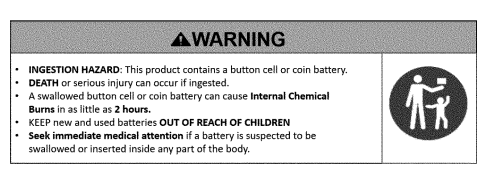
- The texts stated in (c)(5) of section 1263.4 must be included on principal display panel or secondary display panel of consumer product packaging, or on accompanying hang tag or sticker label if no packaging provided
- Warning label requirements for consumer products containing button cell or coin battery
- Warning shown in Figure 10 to paragraph (d)(1) of section 1263.4 must be marked on consumer products

- If the space is limited, icon shown in Figure 11 to paragraph (d)(2) must be present on product display panel, and the icon must be defined in accompanying printed materials such as instructions, manual, insert or hangtag
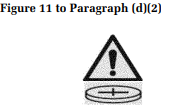
- If the product is too small, the product must have packaging containing the warning label specified in point 4 above, or must have hangtag or sticker label with full warning label specified in Figure 7 to paragraph (c)(1) of section 1263.4
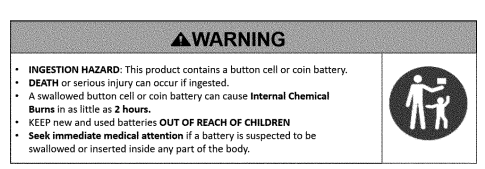
- Instructions / manuals accompanying consumer products containing button cell and coin batteries
- If instructions or manuals are provided, the warning label shown in Figure 7 to paragraph (c)(1) of section 1263.4 and the warning statements described in (e) of section 1263.4 must be included
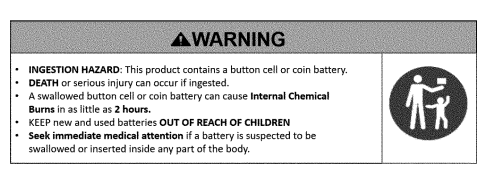
- If instructions or manuals are not provided, the warning requirement in point 6) a) must be present on the principal display panel or secondary display panel of the consumer product packaging, or if there is no consumer product packaging, the accompanying hang tag or sticker label must contain the warning requirement
- Online information
- For button cell or coin batteries, the warning in Figure 4 to paragraph (b)(1) ) of section 1263.4 shall be included next to the product description, the product image, or the product price
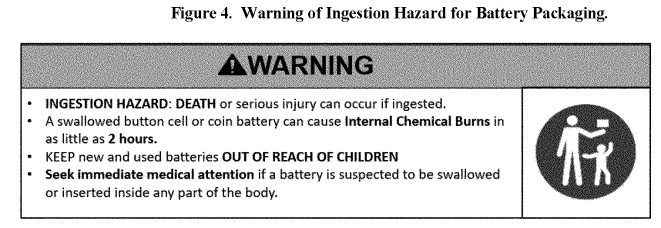
- For consumer products containing button cell or coin batteries, the warning in Figure 7 to paragraph (c)(1) of section 1263.4 shall be included next to the product description, the product image, or the product price
In addition, 16 CFR Part 1263 was added in 16 CFR Part 1112.15, meaning that third party conformity assessment bodies must be accredited to add 16 CFR Part 1263 to their testing scope in order to assess conformity of the aforementioned requirements.
Manufacturers and distributors should assess products to ensure compliance to these newly identified requirements.
In the US, when hazards are identified in consumer products, they will be recalled and published in the Consumer Product Safety Commission (CPSC) Recent Recalls on the CPSC website, which is updated daily. The US recalls from 01 February 2023 to 28 February 2023 are summarized below:
View Story Read More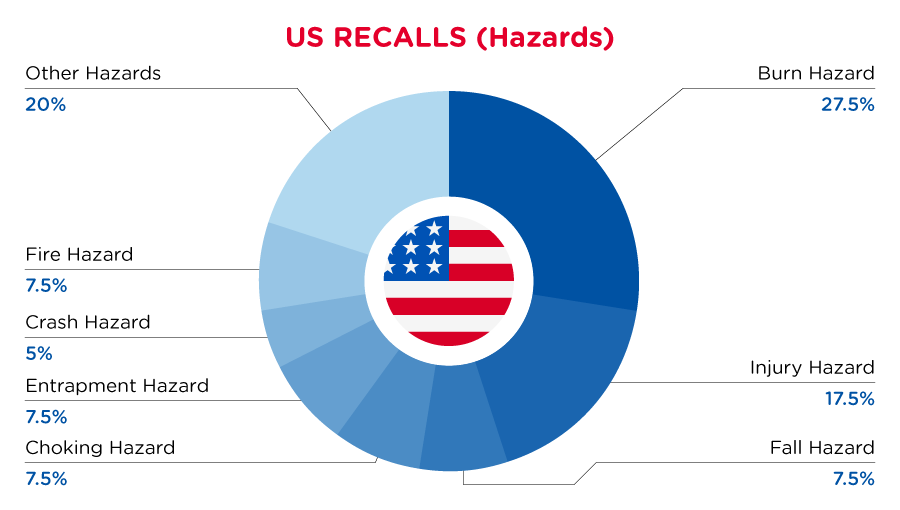
| Hazards | Frequency |
| Burn Hazard | 11 |
| Injury Hazard | 7 |
| Fall Hazard | 3 |
| Choking Hazard | 3 |
| Entrapment Hazard | 3 |
| Crash Hazard | 2 |
| Fire Hazard | 3 |
| Other Hazards* | 8 |
*Other Hazards include Microbiological Hazard, Impact Hazard, Chemical Hazard, Tip-Over Hazard, Death Hazard, Drowning Hazard, Asphyxiation Hazard and Laceration Hazard with a frequency of less than 2.
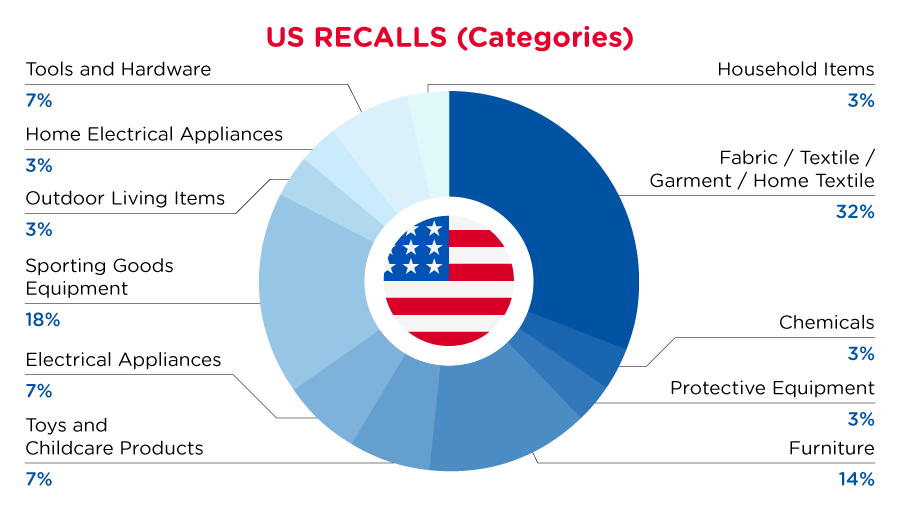
| Product Categories | Frequency |
| Fabric / Textile / Garment / Home Textile | 9 |
| Chemicals | 1 |
| Protective Equipment | 1 |
| Furniture | 4 |
| Toys and Childcare Products | 2 |
| Electrical Appliances | 2 |
| Sporting Goods / Equipment | 5 |
| Outdoor Living Items | 1 |
| Home Electrical Appliances | 1 |
| Tools and Hardware | 2 |
| Household Items | 1 |
For a complete list click here
In Canada, when hazards are identified in consumer products, they will be recalled and published in the Recalls and Safety Alerts Database on the Health Canada website, which is updated daily. The Canada recalls from 01 February 2023 to 28 February 2023 are summarized below:
View Story Read More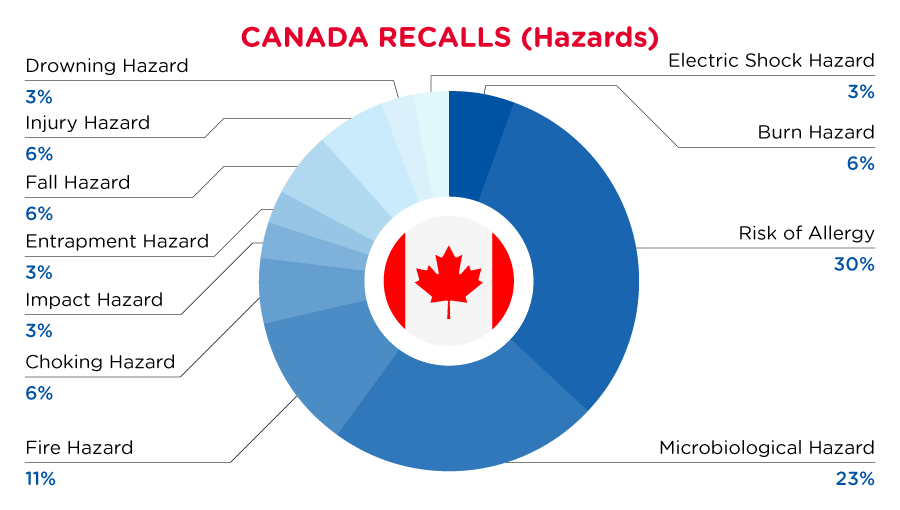
| Hazards | Frequency |
| Burn Hazard | 2 |
| Risk of Allergy | 11 |
| Microbiological Hazard | 8 |
| Fire Hazard | 4 |
| Choking Hazard | 2 |
| Impact Hazard | 1 |
| Entrapment Hazard | 1 |
| Fall Hazard | 2 |
| Injury Hazard | 2 |
| Drowning Hazard | 1 |
| Electric Shock Hazard | 1 |
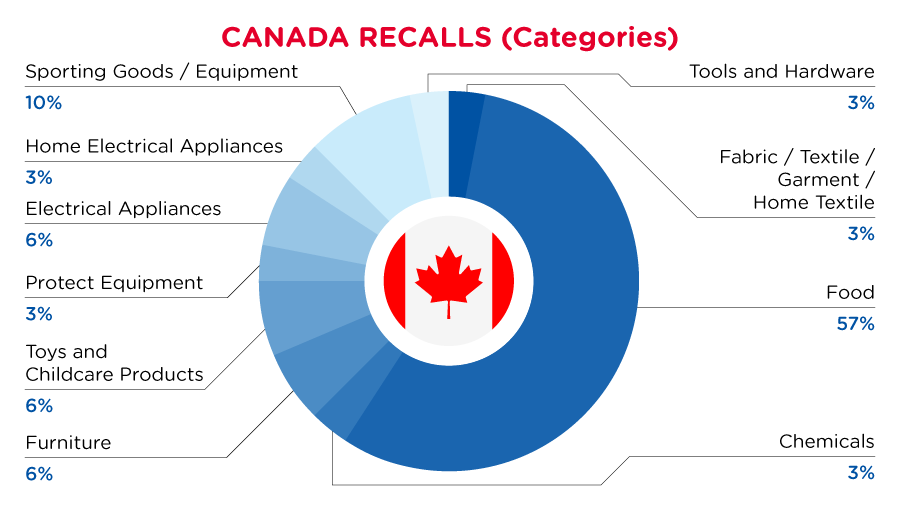
| Product Categories | Frequency |
| Fabric / Textile / Garment / Home Textile | 1 |
| Food | 18 |
| Chemicals | 1 |
| Furniture | 2 |
| Toys and Childcare Products | 2 |
| Protective Equipment | 1 |
| Electrical Appliances | 2 |
| Home Electrical Appliances | 1 |
| Sporting Goods / Equipment | 3 |
| Tools and Hardware | 1 |
For a complete list click here
In Australia, when hazards are identified in consumer products, they will be recalled and published in the Recalls and Safety Alerts Database on the Australian Competition & Consumer Commission website, which is updated daily. The Australia recalls from 01 February 2023 to 28 February 2023 are summarized below:
View Story Read More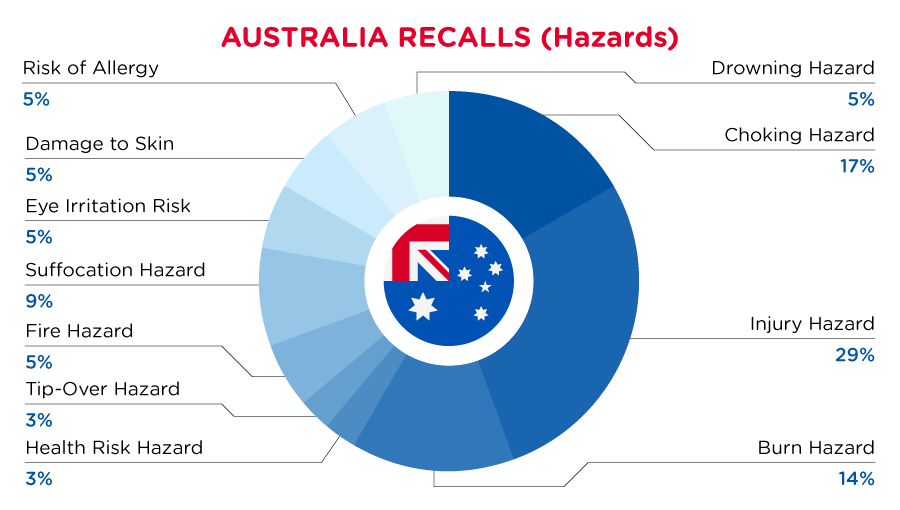
| Hazards | Frequency |
| Choking Hazard | 6 |
| Injury Hazard | 10 |
| Burn Hazard | 5 |
| Health Risk Hazard | 1 |
| Tip-Over Hazard | 1 |
| Fire Hazard | 2 |
| Suffocation Hazard | 3 |
| Eye Irritation Risk | 2 |
| Damage to Skin | 2 |
| Risk of Allergy | 2 |
| Drowning Hazard | 2 |
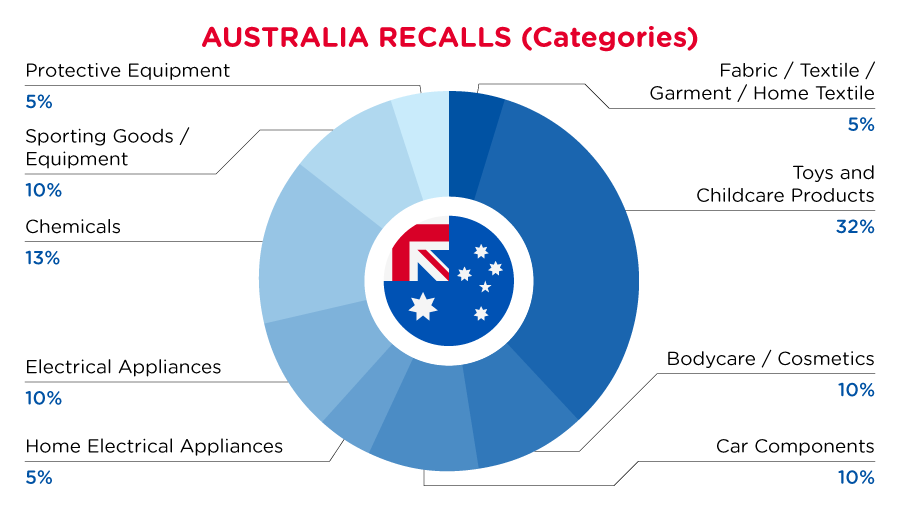
| Product Categories | Frequency |
| Fabric / Textile / Garment / Home Textile | 1 |
| Toys and Childcare Products | 7 |
| Bodycare / Cosmetics | 2 |
| Car Components | 2 |
| Home Electrical Appliances | 1 |
| Electrical Appliances | 2 |
| Chemicals | 3 |
| Sporting Goods / Equipment | 2 |
| Protective Equipment | 1 |
For a complete list click here
The European Commission (EC) launched a one-month consultation on the proposal of restriction of perfluorohexane sulfonic acid (PFHxS), its salts and PFHxS-related compounds under the Persistent Organic Pollutants (POP) recast regulation.
View Story Read MoreOn 9 February 2023, the European Commission (EC) launched a one-month consultation on the proposal of restriction of perfluorohexane sulfonic acid (PFHxS), its salts and PFHxS-related compounds under Annex I Part A of Regulation (EU) 2019/2021 – the Persistent Organic Pollutants (POP) recast regulation. This proposal was launched as part of the European Union’s internal commitments under the Stockholm Convention on persistent organic pollutants (chemical substances). Comments for the proposed regulation were collected until 9 March 2023. The proposal has been delayed as it was originally planned for adoption in the fourth quarter of 2022.
The highlights of the proposed regulation are listed as below:
| Substances Name | Scope | Limit |
| PFHxS and its salts | Substances, mixtures or articles | ≤ 0.025 mg/kg |
| PFHxS-related compounds | ≤ 1 mg/kg (sum of all PFHxS-related compounds) | |
| PFHxS and PFHxS-related compounds | Firefighting foam mixtures | ≤ 0.1 mg/kg (to be reviewed within three years after implementation of this amending regulation with a view to lower the limit) |
On 7 February 2023, the European Chemical Agency (ECHA) published the proposal on the restriction of per- and polyfluoroalkyl substances (PFASs) and provided a planned timeline for their development.
View Story Read MoreOn 7 February 2023, the European Chemical Agency (ECHA) published the proposal on the restriction of per- and polyfluoroalkyl substances (PFASs), a unique family of approximately 10,000 substances which are very persistent in the environment. A detailed timeline with two different restriction proposals has been given. Its scientific committees for Risk Assessment (RAC) and Socio-Economic Analysis (SEAC) will now start evaluating the proposal. A six-month consultation is expected to start on 22 March 2023.
The restriction proposal was prepared by the five EU national authorities of Denmark, Germany, the Netherlands, Norway and Sweden and is intended to protect humans and the environment.
The proposal defines PFAS as “any substance that contains at least one fully fluorinated methyl (–CF3) or methylene (–CF2–) carbon atom (without any H/Cl/Br/I attached to it).”
Some important planned timelines of this PFAS restriction proposal are listed below:
| Action | Timeline |
| Starting of six-month consultation | 22 March 2023 |
| Online information session to explain the restriction process | 5 April 2023 |
| Six-month consultation ends | 22 September 2023 |
| Opinion of RAC and SEAC | 2024 |
| Commission decision and entry into force | 2025 |
| Restriction becomes effective | 2026 or 2027 |
Highlights of the proposed restriction with two options are shown in below table.
| Restriction option | Scope | Requirement | Remark |
| Option 1 | Full ban | Prohibited |
|
| Option 2 | Substances on their own | Prohibited |
|
| Constituents of other substances, mixtures or articles | ≤ 25 ppb for any targeted PFAS (polymeric PFASs exempted) ≤ 250 ppb for sum of targeted PFAS (polymeric PFASs exempted) ≤ 50 ppm for PFASs, including polymeric PFASs* |
*If total fluorine exceeds 50 mg/kg, proof for the fluorine measured as content of either PFASs or non-PFASs is required, if requested by enforcement authorities
The European Chemical Agency (ECHA) has launched a public consultation for the 29th update of the SVHC candidate list. The public consultation period will end on 3 April 2023.
View Story Read MoreOn 17 February 2023, the European Chemical Agency (ECHA) launched the public consultation of the 29th update of the Substances of Very High Concern (SVHC) candidate list. The public consultation period will end on 3 April 2023. Two chemical substances have been proposed as SVHC for public consultation. If the two proposed substances are identified as SVHC, this will bring the total to 235 entries of SVHC in the candidate list which is expected to be finalized in June or July 2023.
The details of the 2 proposed SVHC substances are listed as below:
| Name | CAS Number | Reason for Inclusion | Potential Usage |
| Bis(4-chlorophenyl) sulphone (BCPS) | 80-07-9 | Very persistent and very bioaccumulative (REACH Article 57 e) |
|
| Diphenyl(2,4,6-trimethylbenzoyl)phosphine oxide | 75980-60-8 | Toxic for reproduction (REACH Article 57 c) |
|
The European Commission has issued a proposal for revision to the food contact plastic regulation. The revision is proposed to enter into force in the second quarter of 2023.
View Story Read MoreOn 23 January 2023, the World Trade Organization (WTO) circulated document 23-0494 which is a draft regulation from the European Commission on the revision of Annex I of Regulation (EU) 10/2011 – a specific regulation for plastic materials and articles intended to come into contact with food. Such proposal is based on the recent scientific opinions from the European Food Safety Authority (EFSA) on new substances that may be used in food contact materials and also on the uses of already approved substances.
According to the WTO document and draft regulation, the proposed timelines are listed as below:
- Final date of receiving public comment – 24 March 2023
- Proposed date of adoption – 31 March 2023
- Proposed date of publication – 3 April 2023
- Brought into force – 20 days after its publication in the Official Journal of the European Union
The draft regulation contains several important updates to Annex I of Regulation (EU) 10/2011 which include:
- Deletion of authorizations of food contact material (FCM) substance nos. 96 (wood flour and fibers, untreated) and 121 (salicylic acid) on the Union list
- Replacement of nine FCM substance nos., including strengthened specific migration limit (SML) for DBP (2.5 fold), BBP (5-fold) and DEHP (2.5-fold) and new requirements for the restriction of group substances (total SML.) (Details included in below table)
- Adjustment to specification of FCM 1059 (Poly((R)-3-hydroxybutyrate-co-(R)-3-hydroxyhexanoate, PHBH)
- Extension of use from poly(ethylene terephthalate) (PET) to poly(ethylene 2,5-furandicarboxylate) (PEF) of FCM 1007 (diethyl[[3,5-bis(1,1-dimethyl)-4-hydroxyphenyl]methyl] phosphate)
- Addition of five new substances including:
- FCM no. 1078 (tris(2-ethylhexyl) benzene-1,2,4-tricarboxylate)
- FCM no. 1080 (triethanolamine-perchlorate, sodium salt) dimer)
- FCM no. 1081 (N, N-bis(2-hydroxyethyl)stearylamine partially esterified with saturated C16/C18 fatty acids)
- FCM no. 1082 (Phosphoric acid, mixed esters with 2-hydroxyethyl methacrylate)
- FCM no. 1083 (Benzophenone-3,3’,4,4’-tetracarboxylic dianhydride)
- Replacement of three entries in group restriction of substances, including the consideration of DIBP in group restriction no. 32. According to group restriction no. 32, DIBP (FCM no. 1085) is not listed as an authorized substance. It may co-exist with other phthalates due to its use as a polymerization aid and thus is included in group restriction with the assignment FCM no. 1085.
- Addition of three new entries to group restriction of substances, including group restriction no. 36 where the sum of four phthalates (DBP, BBP, DEHP and DIBP) is expressed as DEHP equivalents.
Comparison of changes of four phthalates (DBP, BBP, DEHP and DINP) listed in Annex I of Regulation (EU) 10/2011:
| FCM no. – Substance name | Current Limit | New Proposed Limit |
| FCM no. 157 – DBP (phthalic acid, dibutyl ester) | SML = 0.3 mg/kg Total SML group restriction no. 32 |
SML = 0.12 mg/kg Total SML group restriction no. 32 and 36 |
| FCM no. 159 – BBP (phthalic acid, benzyl butyl ester) | SML = 30 mg/kg Total SML group restriction no. 32 |
SML = 6 mg/kg Total SML group restriction no. 32 and 36 |
| FCM no. 283 – DEHP (phthalic acid, bis(2-ethylhexyl) ester) | SML = 1.5 mg/kg Total SML group restriction no. 32 |
SML = 0.6 mg/kg Total SML group restriction no. 32 and 36 |
| FCM no. 728 – DINP (phthalic acid, diesters with primary, saturated C8-C10 branched alcohols, more than 60% C9) | No SML requirement Total SML = 9 mg/kg (sum of DINP and DIDP, group restriction no. 26) |
Not to be used in combination with FCM no. 157, 159, 283 or 1085 Total SML = 1.8 mg/kg (sum of DINP and DIDP, group restriction no. 26) |
Note: DIDP - phthalic acid, diesters with primary, saturated C9-C11 alcohols more than 90% C10; DIBP – diisobutyl phthalate
The Commission also proposed that those plastic materials and articles complying with the current food contact regulation before the entry of this amendment, are allowed to be placed in the market with an 18-month transition period after the entry of this amendment and may remain on the market until stocks are depleted.
In Europe, when hazards are identified in non-food consumer products, the products will be recalled and published in the Safety Gate system, which is updated weekly. The European recalls from 01 February 2023 to 28 February 2023 are summarized below:
View Story Read More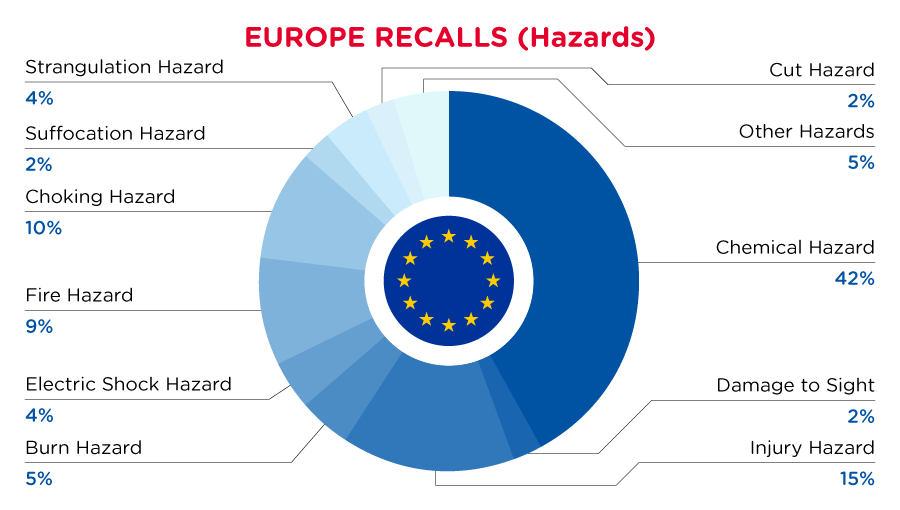
| Hazards | Frequency |
| Chemical Hazard | 102 |
| Damage to Sight | 6 |
| Injury Hazard | 36 |
| Burn Hazard | 11 |
| Electric Shock Hazard | 10 |
| Fire Hazard | 22 |
| Choking Hazard | 23 |
| Suffocation Hazard | 6 |
| Strangulation Hazard | 10 |
| Cut Hazard | 6 |
| Other Hazards* | 11 |
*Other Hazards include Drowning Hazard, Environmental Hazard, Aspiration Hazard, Health Risk Hazard and Entrapment Hazard with a frequency of less than 4.
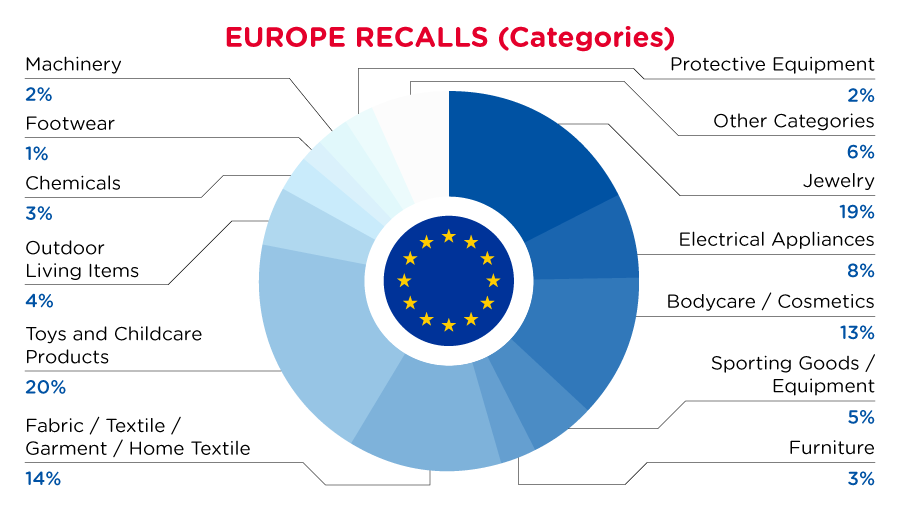
| Product Categories | Frequency |
| Jewelry | 35 |
| Electrical Appliances | 14 |
| Bodycare / Cosmetics | 24 |
| Sporting Goods / Equipment | 11 |
| Furniture | 6 |
| Fabric / Textile / Garment / Home Textile | 26 |
| Toys and Childcare Products | 38 |
| Outdoor Living Items | 10 |
| Chemicals | 6 |
| Footwear | 4 |
| Machinery | 5 |
| Protective Equipment | 5 |
| Other Categories* | 13 |
*Other Categories include Tools and Hardware, Household Items, Stationery, Home Electrical Appliances, Accessories and Construction Products with a frequency of less than 4.
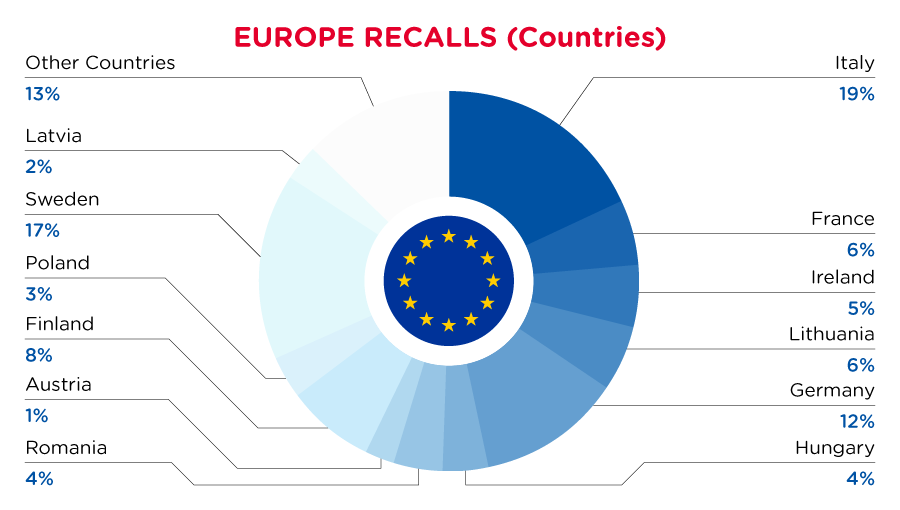
| Notifying Country | Frequency |
| Italy | 36 |
| France | 11 |
| Ireland | 10 |
| Lithuania | 11 |
| Germany | 24 |
| Hungary | 8 |
| Romania | 8 |
| Austria | 5 |
| Finland | 15 |
| Poland | 7 |
| Sweden | 31 |
| Latvia | 6 |
| Other Countries* | 25 |
*Other Countries include Bulgaria, Luxembourg, Malta, Belgium, Czechia, Cyprus, Croatia, Slovakia, The Netherlands and Greece with a frequency of less than 5.
For a complete list click here
The Hong Kong government launched an update of the Toys and Children’s Products Safety Ordinance (Cap. 424) to implement up-to-date safety standards promulgated by the relevant standards institutions for children’s products listed in Schedule 2 to the Ordinance (Schedule 2 products).
The effective date will be 1 August 2023.
The Toys and Children’s Product Safety Ordinance (Cap. 424) stipulates that a person must not manufacture, import or supply a toy or a children’s product unless it complies with all the applicable requirements contained in any one of the safety standards respectively specified in Schedules 1 and 2 to the Ordinance. The standards specified are international standards or standards adopted by major economies.
The Hong Kong government launched the update, effective 1 August 2023, which amends Schedule 2 to the Ordinance relative to four classes of Schedule 2 products (Children’s products) as mentioned:
| Categories | Current Specified Standards | Updated Standards | Summary of Standard Changes |
| Bunk beds for domestic use | ASTM F1427-21 | ASTM F1427-21e1 | To revise the warning labels by boldfacing the words “To help prevent” on the label |
| Child safety barriers for domestic use | ASTM F1004-19 | ASTM F1004-21 | USA: CPSC Updates Final Rule of Safety Standard for Gates and Enclosures (16 CFR 1239) (qima.com) |
| Children’s high chairs and multi-purpose high chairs for domestic use | ASTM F404-20 | ASTM F404-21 | USA: The US Consumer Product Safety Commission (CPSC) has published a Final Rule for Infant Walkers (qima.com) |
| Wheeled child conveyances | ASTM F833-19 | ASTM F833-21 | USA: CPSC Publishes Direct Final Rule for Carriages and Strollers (qima.com) |
The China State Administration of Market Supervision and Administration (the National Standardization Administration Commission) has published the National Standard of Shoe Size (GB/T 43293-2022), replacing GB/T 3293.1-1998. 国家标准 - 全国标准信息公共服务平台 (samr.gov.cn).
GB/T 43293-2022 will be officially implemented on 1 May 2023.
National Standard GB/T 43293-2022 - Shoe Size is applicable to all shoe categories and replaces Standard GB/T 3293.1-1998 for Shoe Size. It will officially go into effect on 1 May 2023.
The main updates in comparison to GB/T 3293.1-1988, include but are not limited to, those identified below:
- Indication of shoe size UPDATED
- Foot length (mandatory)
- Linear width of the foot (required, if necessary)
- Marking format requirement of the world’s shoe sizes ADDED
- Conversion with other world’s shoe sizes ADDED
- Refer to standard GB/T 36935 Footwear - Conversion of Sizing Systems
- Font height requirement of shoe size labelling REMOVED
- Required following standard QB/T 2673 Footwear - Specification of Marking
Important notes:
- There is no impact for shoe size labelling which already complied with the current standard GB/T 3293.1-1998. The shoe size labelling which meets with current standard GB/T 3293.1-1998 will also meet with the marking requirements of new standard GB/T 43293-2022.
In China, when hazards are identified in consumer products, they will be recalled and published in the SAMR Defective Product Administrative Centre, which is updated daily. The China recalls from 01 February 2023 to 28 February 2023 are summarized below:
View Story Read More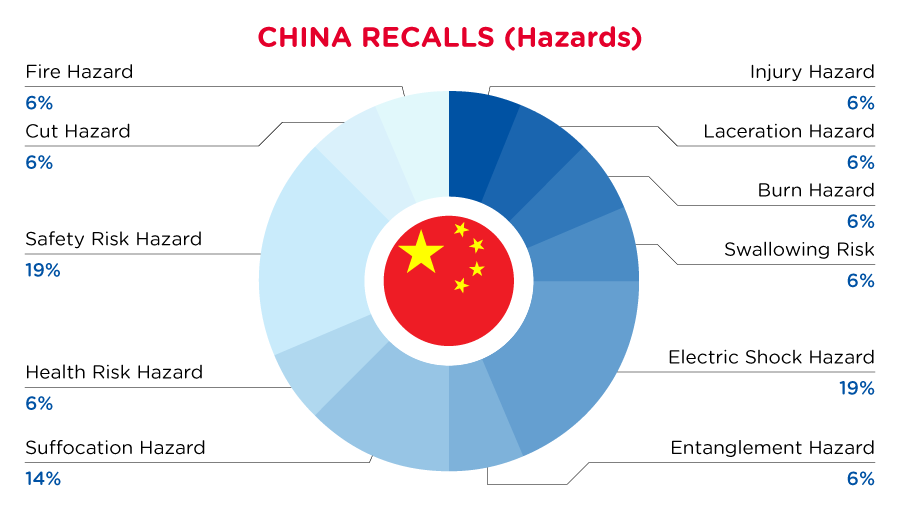
| Hazards | Frequency |
| Injury Hazard | 1 |
| Laceration Hazard | 1 |
| Burn Hazard | 1 |
| Swallowing Risk | 1 |
| Electric Shock Hazard | 3 |
| Entanglement Hazard | 1 |
| Suffocation Hazard | 2 |
| Health Risk Hazard | 1 |
| Safety Risk Hazard | 3 |
| Cut Hazard | 1 |
| Fire Hazard | 1 |
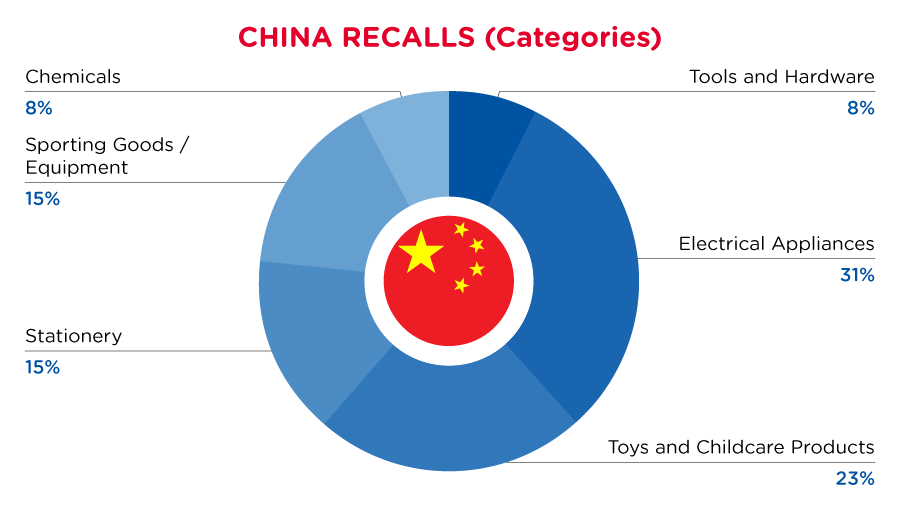
| Product Categories | Frequency |
| Tools and Hardware | 1 |
| Electrical Appliances | 4 |
| Toys and Childcare Products | 3 |
| Stationery | 2 |
| Sporting Goods / Equipment | 2 |
| Chemicals | 1 |

| Provinces | Frequency |
| Shanghai | 6 |
| Hunan | 2 |
| Beijing | 4 |
| Inner Mongolia | 1 |
For a complete list click here

